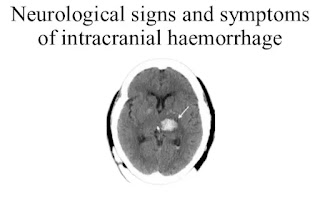What is intracranial hemorrhage?
It is the course of discharge inside the cerebrum. It can happen in any piece of cerebrum like pons, thalamus, cerebellum and so on.
Hypertensive lobar intracerebral hemorrhage.
Cracked vascular aneurysm.
Unsure causes (with ordinary pulse).
Injury drain in the cancer, draining problems, for example thrombocytopenia, hemophilia, leukemia, DIC and so on.
Intracerebral hemorrhage (ICH) is when blood unexpectedly blasts into mind tissue, making harm your cerebrum.
Side effects typically show up out of nowhere during ICH. They incorporate cerebral pain, shortcoming, disarray, and loss of motion, especially on one side of your body. The development of blood comes down on your cerebrum and impedes its oxygen supply. This can rapidly cause cerebrum and nerve harm.
This is a health related crisis requiring prompt treatment. ICH isn't so normal as ischemic stroke (which happens when a vein to your cerebrum is hindered by a coagulation), yet it's more significant.
Treatment relies upon how much blood and the degree of mind injury that has happened. Since the most widely recognized reason for ICH is connected with hypertension, returning your pulse brought and down to normal is the primary key stage. In some cases, a medical procedure is expected to let tension from the collection free from blood and to fix harmed veins.
Long haul treatment relies upon the discharge area and how much harm. Treatment might incorporate physical, discourse, and word related treatment. Many individuals have some degree of extremely durable inability.
Neurological signs and symptoms
Depends on the site and size of the extravasation.
Putaminal hemorrhage (50%): Commonest site of hypertensive hemorrhage. Patient passes immediately in coma with hemiplegia. Face sags to one-side, speech becomes slurred or aphasic, the arms and legs gradually weaken and eyes tend to deviate away from the side, of paretic limbs (These events occur gradually; the paralysis worsens with limbs becoming flaccid, pinprick not appreciated; Babinski's sign appears. Speaking becomes impossible, and confusion gives rise to stupor.
Thalamic hemorrhage: Sensory deficit is either equal or more than motor weakness. Aphasia may be present. Neck retraction is prominent. Pupil unequal, skew deviation, eyes displaced downwards and absence of light reaction.
Pontine hemorrhage: Deep coma ensues within a few minutes. There is total paralysis with rigidity and small (1 mm) pupils that react to light, lateral eye movements are impaired.
C.S.F is consanguineous.
Death usually occurs in a few hours.
Cerebellar hemorrhage: It develops over a period of several hours, and loss of consciousness at onset is rare. Repeated vomiting along with inability to walk or stand. Occipital headache and vertigo are prominent features.
Contralateral hemiplegia, small reactive pupils, ataxia etc.
Forced deviation of eyes to the opposite side of lesion. Dysarthria and dysphagia may be prominent.
Investigation
Blood exam: W.B.C: 15,000 to 20,000/cu mm. ESR elevated.
CT scan: It is totally reliable in the detection of hemorrhage, also helps in revealing tumor, cerebral swelling, hydrocephalus and displacement of intracranial contents.
MRI
CSF examination
X-ray chest
EEG
Platelet count, bleeding and clotting time, prothrombin and partial thromboplastin times.
Liver and kidney function tests.
Differential diagnosis
Cerebral thrombosis and embolism
Subarachnoid hemorrhage
Cerebral tumors
Treatment (CVA)
General medical management in the acute stage.
Hospitalization.
Measures to restore the circulation and arrest of the pathological precess.
Physical therapy and rehabilitation.
Preventive measures against strokes and vascular diseases.
Surgical help.
Decompression, hematoma removal.
Homeopathic medicines (Expert Homeopathy)
Apoplexy: Aconite, Arnica, Belladonna, Lachesis, Opium, Phosphorus.
Arteriosclerosis: Allium Sativum, Ammon iod, Arsenicum Iod, Glonoin, Natrum Iod.
Hemiplegia: Arnica, Aurum Mur, Barita Carb, Bothrops, Causticum, Lachesis.
Arnica Montana: First remedy to be used in cases of all cerebrovascular accidents. It prevents both coagulation and resolve clot, helping in maintaining a normal blood flow. Its effects are clinically verified.
Opium: A remedy for comatose patient; often helps in reviving the patient.
Aconite Napellus: Quick, full pulse; repeat the dose every quarter of an hour.
Belladonna: This should be prescribed in very early symptoms during apoplexy, if the face is flushed and the head is full and throbbing (great redness of face, bloated appearance, active congestion, drowsiness and loss of consciousness)
Nux Vomica: In cases of less active congestion and fever, with error in diet.
Baryta Carbonica: For old people, and impending paralysis, when the tongue is complicated.
Hyoscyamus: For involuntary passage of stool and urine.
Sulphur: For absorption of the clot after Arnica and Kali muriaticum.


Post a Comment